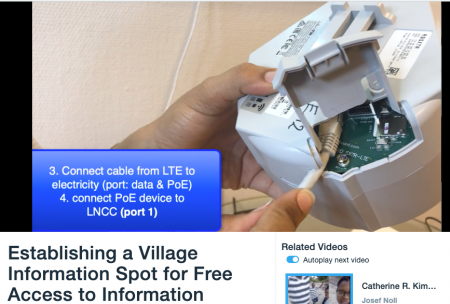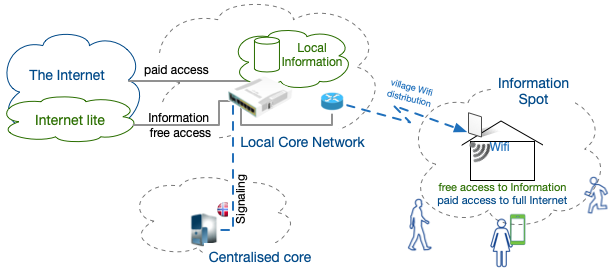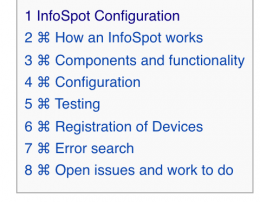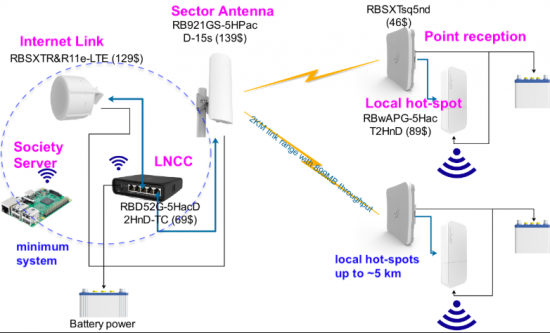BasicInternet:Solutions
From its-wiki.no
| Solutions | |||||||
|---|---|---|---|---|---|---|---|
|
Solutions for Internet Lite
When providing Internet in areas with low availability or high costs the focus is on getting as much information as possible through a thin (or bandwidth limited link). Examples of such low availability links are satellite links, bad coverage from mobile networks or congested mobile networks.
Basic Internet provides solutions which optimise the information stream such that a high amount of information can be provided. This information optimization is done in the Basic Internet Core Network or through technologies of our partners. Our infrastructure is based around a Local Information Spot, getting the Internet typically through a mobile network link, and distributing both Information from the Internet, as well as Local Content through a local Wifi Hot-Spot (see Figure 1).In order to have a cost effective solution, the Local Core Network and the Information spots are often integrated as one unit.
Our distributed architecture opens for a quick deployment of a cost-effective Internet distribution worldwide, allowing for
- A reception of a 3G/4G network even in areas with no connectivity. Our examples have proven that we connect even in places without connectivity:
- Selela at the border of the Serengeti, reaching the mobile tower being about 22 km away
- Izaziin the Iringa district, hidden by the mountain ridge between Izazi and the mobile towers in Migoli
- In both cases we put up a 6 m pole, and mounted a directive antenna, both together increasing the mobile network by about 18 dB.
In areas without electricity, we can establish the InfoSpot based on a solar panel
- In Esilalei_(TZ) we used a 120 W solar panel and a 50 Ah battery for providing electricity for 3 lamps, mobile charging and the power for our equipment.
The goal of establishing the InfoSpot:
- Free configurable provision of educational, informational and global content.
Our aim of Internet Lite for All requires as little as 4.5 MegaByte (MB) per user and month, which is about the size of one .mp3 music file. - A high-bandwidth local distribution network supporting local collaboration and content distribution
The village/society server can be preloaded with education, health or other information, with content being freely available for everyone - A business option for providing premium Internet
The freemium model of access promotes free access to information (text, pictures and local video), and premium access to entertainment, games and other bandwidth-demanding content. Premium access is part of the Basic Internet solution through the sales of vouchers.
In the easiest way (see Figure 2), the infrastructure consists of the local network, generating one information spot. Only three components are used: The Internet link reception of the mobile broadband signal, the local network control centre (LNCC) and the society server. (see Figure 4 and Figure 3, the video https://vimeo.com/354375901)

Cost examples
A typical cost example (status: Okt2018) is presented in Figure 4. From left to right, it shows the reception of the Internet link (back-bone, IP-link), the local network control centre (LNCC), the point to multipoint antenna, and the local hot-spot. In short, the functionality is as follows:
- The Internet link reception is either performed through a directive link, or through re-using the mobile 3G/4G/5G network. The link directly feeds the LNCC.
- Internet Antenna: SXT LTE6 Kit 2023 (SXTR&FG621-EA, https://mikrotik.com/product/sxt_lte6_2023) (previously RBSXTR&R11e-LTE)
- LTE kit 2G/3G/4G/LTE High gain 17dBI CPE for very remote areas - https://mikrotik.com/product/lhg_lte_kit
- 5G reception using the Multi-MIMO capabilities, Zyxel 5G NR Outdoor Router, see https://service-provider.zyxel.com/global/en/products/5g-nr4g-lte-cpe/5g-nr-cpe/odus/nr7303
- The Local Network Control Centre (LNCC) performs the filtering for the freemium access, with free access to information begin text, pictures and local information from the Society Server, and premium access to bandwidth-demanding services from the Internet. The LNCC is connected to the Society Server for access to free local content, and provides this information to the Multipoint antenna.
LNCC: RBD52G-5HacD 2HnD-TC - see: https://mikrotik.com/product/hap_ac2
- The Society Server (Raspberry Pi, example: http://Yeboo.com or http://Yeboo.BasicInternet.org) contains information such as health, education and entrepreneurial information, being freely available for everyone in the society. - For educational purposes, we recommend setting up Moodle, see link to Moodle usage.
Raspberry Pi - Model 3B+
The network can be expanded to other access points using
- The Multipoint Antenna generates a 90 deg sector link coverage for any hot-spot connecting to it.
- The Local Hot-Spot consists of two parts, a receiver unit with a directive antenna to communicate with the Multipoint antenna, and the local hotspot device. If the distance to the Multipoint Antenna (Village information spot) is less than 1 km, then we can omit the receive unit and work with only the local hotspot.
The Basic Internet Infrastructure is modular and applicable, including
- Mobile and fixed Hotspot, e.g. a car solution using a 3G/4G modem connected to a Mikrotik RB951.
This solution has been used to equip hospitals and health stations in Norway since 2012. - Dedicated IP solutions, where the incoming channel is either a radio link, an existing Internet access or a fibre connection.
A solution connected to a backhaul fibre is used in India to enhance the last-mile connectivity. - The solution is especially suited for connectivity within a village or on a campus, allowing all users free access within the campus, free access to information on the Internet and premium access to broadband content.
Read more on
- Steps to go for establishing an InfoSpot
- Configuration of InfoSpots (LTE antenna, LNCC, Raspberry Pi)
- Problem handling after having installed the InfoSpot
- or have a look at our Frequently asked Questions (FAQ)
- specific instructions on how to configure an InfoSpot with all components BasicInternet:InfoSpot_configuration





